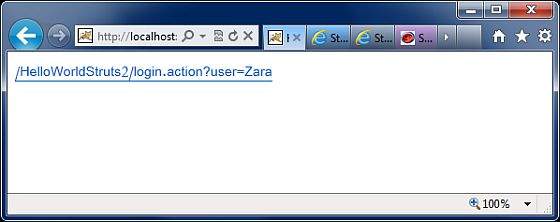Struts 2 - URL 标签
url 标签负责生成 URL 字符串。这样做的好处是您可以向标签提供参数。让我们通过一个例子来展示 url 标签的用法。
创建操作类
package com.tutorialspoint.struts2;
public class HelloWorldAction {
private String name;
public String execute() throws Exception {
return "success";
}
public String getName() {
return name;
}
public void setName(String name) {
this.name = name;
}
}
创建视图
让我们创建包含以下内容的 HelloWorld.jsp −
<%@ page contentType = "text/html; charset = UTF-8"%>
<%@ taglib prefix = "s" uri = "/struts-tags"%>
<html>
<head>
<title>Hello World</title>
</head>
<body>
<s:url id = "login" action = "login" var = "myurl">
<s:param name = "user">Zara</s:param>
</s:url>
<a href = '<s:property value = "#myurl"/>'>
<s:property value = "#myurl"/></a>
</body>
</html>
这里我们生成指向"login.action"的 url 链接。我们给这个 url 取名为"myurl"。这样我们就可以在 jsp 文件中的多个位置重复使用此 url 链接。然后我们为 url 提供一个名为"USER"的参数。从上面的输出中可以看到,参数值实际上附加到了查询字符串中。
URL 标记主要用于您想要基于 bean 的属性值创建动态超链接时。
配置文件
您的 struts.xml 应该看起来像 −
<?xml version = "1.0" Encoding = "UTF-8"?>
<!DOCTYPE struts PUBLIC
"-//Apache Software Foundation//DTD Struts Configuration 2.0//EN"
"http://struts.apache.org/dtds/struts-2.0.dtd">
<struts>
<constant name = "struts.devMode" value = "true" />
<package name = "helloaction" extends = "struts-default">
<action name = "hello"
class = "com.tutorialspoint.struts2.HelloWorldAction"
method = "execute">
<result name = "success">/HelloWorld.jsp</result>
</action>
</package>
</struts>
文件 web.xml 应类似于 −
<?xml version = "1.0" Encoding = "UTF-8"?>
<web-app xmlns:xsi = "http://www.w3.org/2001/XMLSchema-instance"
xmlns = "http://java.sun.com/xml/ns/javaee"
xmlns:web = "http://java.sun.com/xml/ns/javaee/web-app_2_5.xsd"
xsi:schemaLocation = "http://java.sun.com/xml/ns/javaee
http://java.sun.com/xml/ns/javaee/web-app_3_0.xsd"
id = "WebApp_ID" version = "3.0">
<display-name>Struts 2</display-name>
<welcome-file-list>
<welcome-file>index.jsp</welcome-file>
</welcome-file-list>
<filter>
<filter-name>struts2</filter-name>
<filter-class>
org.apache.struts2.dispatcher.FilterDispatcher
</filter-class>
</filter>
<filter-mapping>
<filter-name>struts2</filter-name>
<url-pattern>/*</url-pattern>
</filter-mapping>
</web-app>
右键单击项目名称,然后单击导出 > WAR 文件以创建 War 文件。然后将此 WAR 部署到 Tomcat 的 webapps 目录中。最后,启动 Tomcat 服务器并尝试访问 URL http://localhost:8080/HelloWorldStruts2/hello.action。这将产生以下屏幕 −

 struts_data_tags.html
struts_data_tags.html

